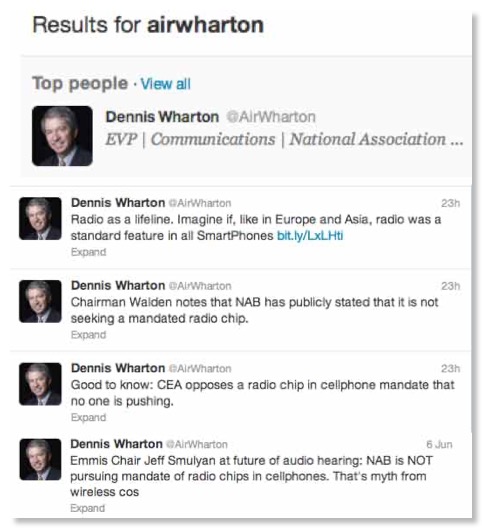NAB's Campaign for FM in Cellphones: Possible Unintended Side Effects

In any case this legislation never gained any traction.
Recently, NAB-related Twitter feeds have been gloating about "voluntary" agreements with cellular carriers to "unlock" the FM demodulator in most or possibly all Android smartphones.
Momentum Grows for FM #Radio in Smartphones | @NAB_Labs http://t.co/4plT8RsFMw
— Jacobs Media (@jacobsmedia) August 25, 2015T-Mobile, AT&T and Sprint back FM chips in cellphones. We (& FEMA's Craig Fugate) welcome Verizon to join the party http://t.co/5ooCmpSS37
— Dennis Wharton (@AirWharton) August 19, 2015In view of the bizarre deal NAB allegedly tried to cut with the record industry on this issue, one wonders what NAB might have offered these cellular carriers? Support for their opposition to net neutrality? Support for their implementation of LTE-U in Wi-Fi bands? (Note that NCTA is strongly against this so supporting it could get back at 2 NAB enemies at the same time!)
Just as this issue is getting resolved bilaterally between the broadcasters and the cellular carriers, there was a piece today on NAB member NBCUniversal's Today Show about the danger from "ear buds" typically used with smartphones. Here is a quote:
"Probably the largest cause [of hearing damage] is millennials using iPods and [smartphones]," says Dr. Sreekant Cherukuri, an ear, nose, and throat specialist from Munster, Indiana. Hearing loss among today's teens is about 30 percent higher than in the 1980s and 1990s, Cherukuri estimates….Cherukuri tells young patients to stop wearing headphones — especially earbuds, which place the sound closer to the ear drum, enhancing volume by as much as 9 decibels. "
Yes, ear buds came with cellphones to be used for voice calls. But the number of minutes of voice calls per phone is not increasing as most millennial prefer texting or e-mail. (Some that is also helpful in the RF safety area.) But encouraging millennials to use their ubiquitous smart phones for long term FM music listening just as the Sony Walkman disappears could raise the very issues that Dr. Cherukuri raises above as an unintended consequence. There are smartphone apps that limit acoustic power to prevent this danger, but we don't see much from either NAB or the cellular industry on why this is important for millennials.
Yes. the Walkman had a similar problem, but they were generally used with headphones not today's ear buds. The website, TeensHealth is the source of the green infographic at the right. It clearly says "Noise-induced hearing loss due to earbuds is 100% preventable if you use them in moderation." If the broadcast industry is so intent on changing the life style of millennials, we hope that pay attention to this key health issue also.




![Validate my RSS feed [Valid RSS]](valid-rss-rogers.png)

